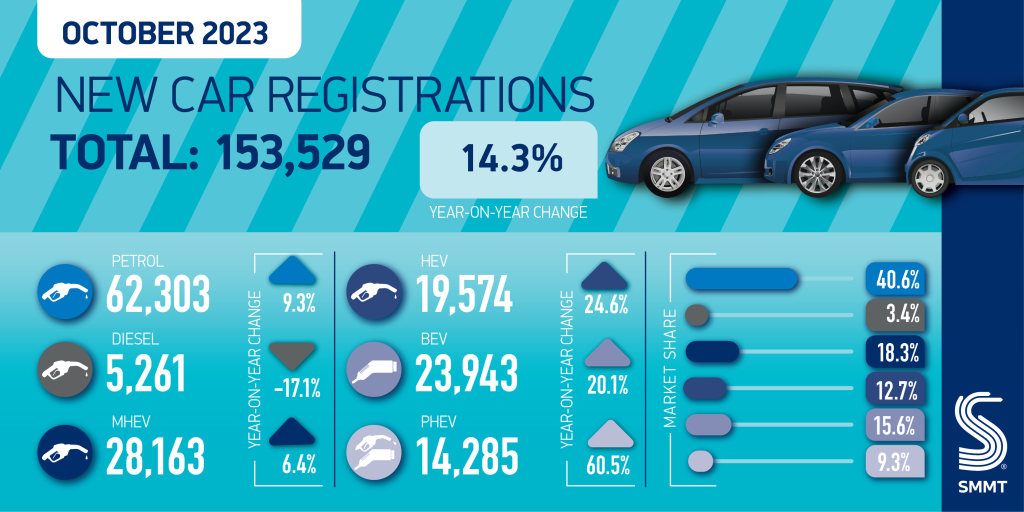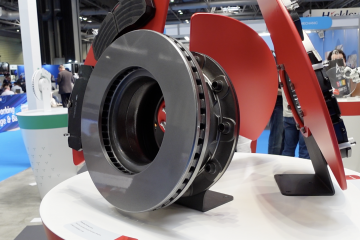The UK new-car market is now in full recovery mode, with October registrations marking the first time that figures have beaten pre-COVID-19 pandemic levels. However, while there is optimism in growth, battery-electric vehicles (BEVs) are continuing to struggle in the private sector.
Last month, registrations in the UK were 14.3% up on the same month in 2022, with the latest figures from the SMMT showing 153,529 new cars took to the country’s roads. The numbers were also 7.2% up on October registrations in 2019.
This is the first time that registration data has improved on pre-COVID-19 pandemic figures, with 2019 held as the benchmark that the market needs to beat to show a return to form. Since then, there have been several challenges affecting the registrations of new cars, including the pandemic itself and associated lockdowns, a supply-chain crisis that impeded vehicle production and deliveries, and an economic crisis that has hit household and business budgets.
However, in the year-to-date, the market is still 19.9% down on the first 10 months of 2019. There is still some way to go for a total recovery, but the October registrations data shows that the industry is setting out on this journey.
Private BEV registrations struggle
The fleet market has driven the UK’s registrations into a 15th consecutive month of growth and has much to do with the rise in figures from across the year.
The October registrations mark the 13th month in a row that fleet deliveries have outperformed those of private deliveries, with last year’s figures heavily in the average consumer’s favour, thanks to eight months in total leading the numbers. Yet since the market saw delivery backlogs start to clear, those to large businesses have been driving the country’s automotive market.
Yet the fleet sector is not just responsible for the UK’s registration growth in 2023, but also the impressive uptake in battery-electric vehicles, with the private sector struggling to adopt the zero-emission technology.
In the October registrations data, BEV uptake increased for the 42nd month in a row with a 20.1% rise in the month working out to 23,943 units. The technology took a 15.6% market share; however, this is only up by 0.8% compared to the same month in 2022. Year-to-date figures were a bit more positive, with growth across the first 10 months of 34.2% meaning the powertrain technology holds 16.3% of the market so far this year, up 1.7%.
However, of the 262,487 BEV registrations in 2023, only 62,478 were in the private sector. This means only 23.8% of deliveries of this zero-emission technology has taken place outside the fleet and small-business market, suggesting a struggle to get consumers engaging with all-electric vehicles.
Why fleet sales matter to the aftermarket
It is easy to look at the October registrations figures and believe that demand for BEVs is not significant enough to take up training on electric vehicle (EV) technology.
However, the independent aftermarket is intrinsically linked with the fleet sector, especially when it comes to second-hand vehicles. The average age for a car to enter the independent sector for its servicing requirements is three years. This is also the time when companies tend to defleet, swapping out older models for new ones. These three-year-old vehicles then enter the second-hand market, where they are more likely to be purchased by buyers who would rather save on servicing costs by using the experience of independent technicians.
Meanwhile, private buyers are purchasing EVs at a higher cost than internal-combustion engine models. As these new vehicles are an investment, they are likely to hold on to them for longer than the 36-month average. They are also more likely to continue their relationship with their franchised dealership in this time.
So while private deliveries are lower in the October registrations tables, the fact that fleet numbers are up, and significantly so, means the aftermarket needs to be ready. Considering fleets have been buying EVs in larger numbers since purchasing returned to normal post-pandemic, we will start seeing these de-fleeted second-hand models coming into the market next year, and this will only increase.
Improvements in charging infrastructure
Plug-in hybrid (PHEV) registrations also improved in the October registrations, with the 14,285 deliveries up 60.5% on the same month last year, a 9.3% market share that was a 2.7% improvement on October 2022. This means that the entire plug-in market took 24.9% of the total market in the month.
The performance of plug-in models follows a significant increase in the UK’s charge point rollout during the third quarter of 2023. According to SMMT data, 4,753 new standard points, the largest quarterly total, came online between July and September, equating to one new public location for every 26 plug-in vehicles taking to the roads in the same period. This was an improvement from the one to 38 ratio during the same period last year.
However, installation was disproportionately focused on London and the south-east, which received four out of five new charge points commissioned during the quarter, despite the region accounting for fewer than two in five new plug-in registrations during the same period. In comparison, just 13 chargers were installed in Yorkshire and Humberside, while the north saw 105 chargers taken out of service.
This lack of even distribution across the UK could impact private BEV registrations in particular, with many potential buyers likely to rely on the public charging infrastructure, especially those without access to off-street parking. The SMMT is calling for finding targets for charge point rollout, in line with those set for the automotive market by the Zero Emission Vehicle Mandate. This would also need to be supported by the necessary changes to planning and grid connections, which would also help accelerate installations.
Petrol leads October registrations
The poor performance in the private sector during the October registrations period does not take away from the fact that BEVs were the second-best fuel-type in the UK once again during October. Their uptake in the fleet market will also translate into the second-hand segment in three years, as these businesses defleet, giving private buyers who cannot afford a new model the opportunity to experience zero-emission motoring.

Petrol once again led figures in the October registrations data, with 84,451 units, including petrol mild hybrids. This was an improvement of 8.3% against last year, however the market share of the fuel slipped by 3%, and now sits at a 55% hold. Diesel suffered yet another month of losses, with 11,276 units, including mild hybrids, equating to a 4.5% fall. At just a 7.3% market share, the fuel dropped to the bottom of the chart in October.
In the year-to-date numbers, petrol-powered cars have increased their registrations tally by 17.4%, with a market share of 56.4%, down by 1% against last year. Diesel has seen deliveries drop 9.4% in the first 10 months, with a 7.6% market share, down by 2.4%. However, this is above the share for PHEVs, although there is just 0.5% between them.
Hybrids saw a 24.6% improvement in the October registrations data, with their 19,574 deliveries holding 12.7% of the market. So far in 2023, hybrid registrations are up by 27.8%, placing them firmly in third place amongst the fuel types.




You must be logged in to post a comment.